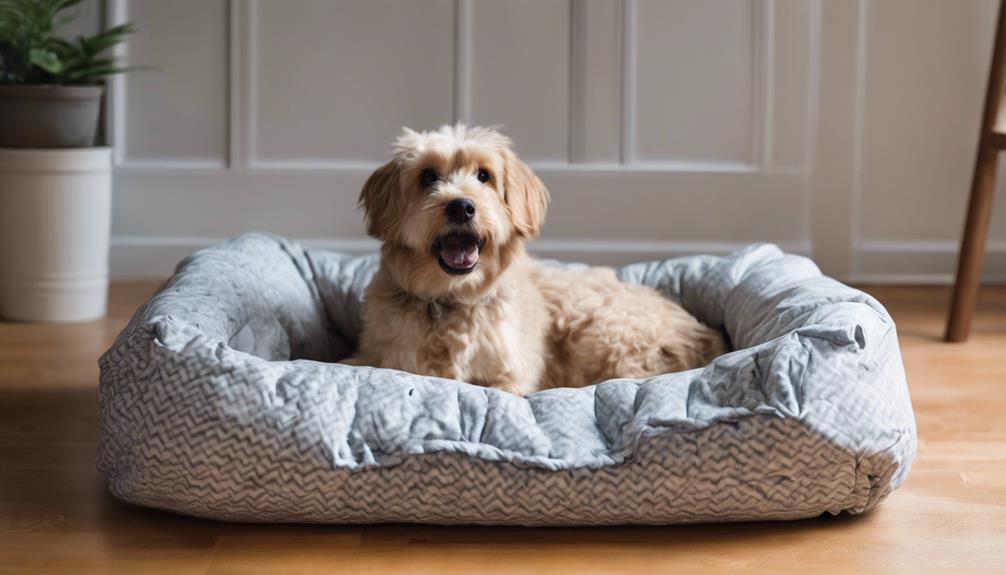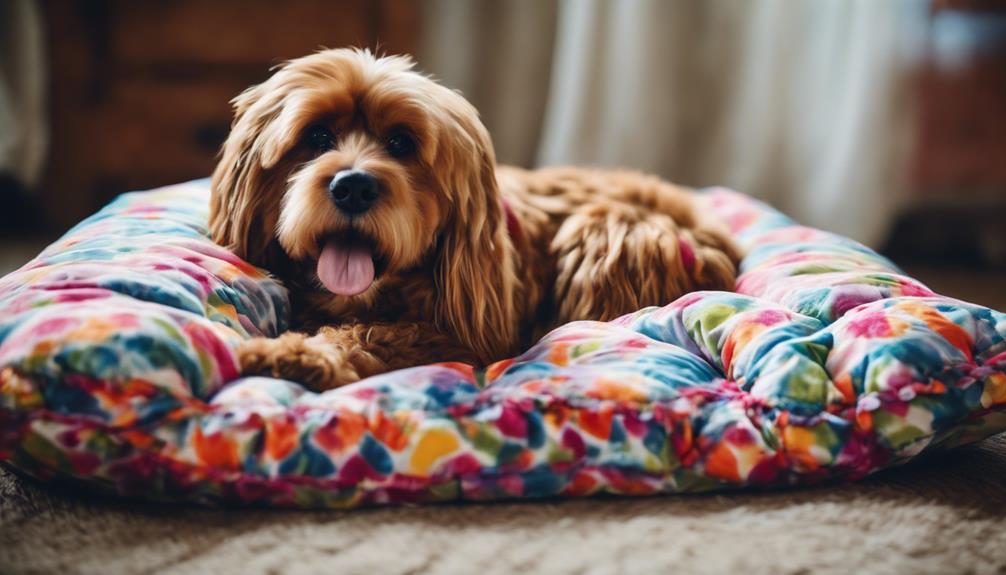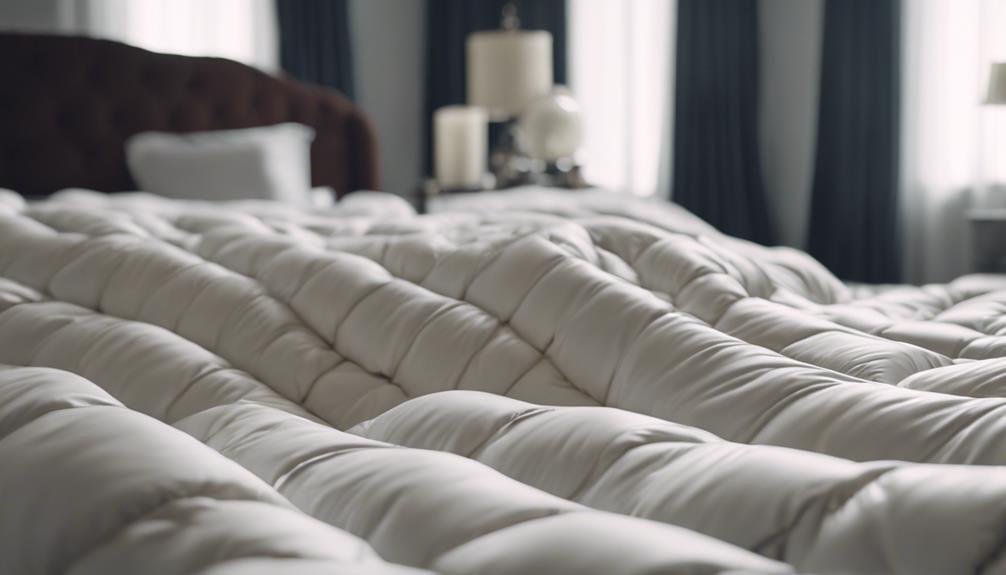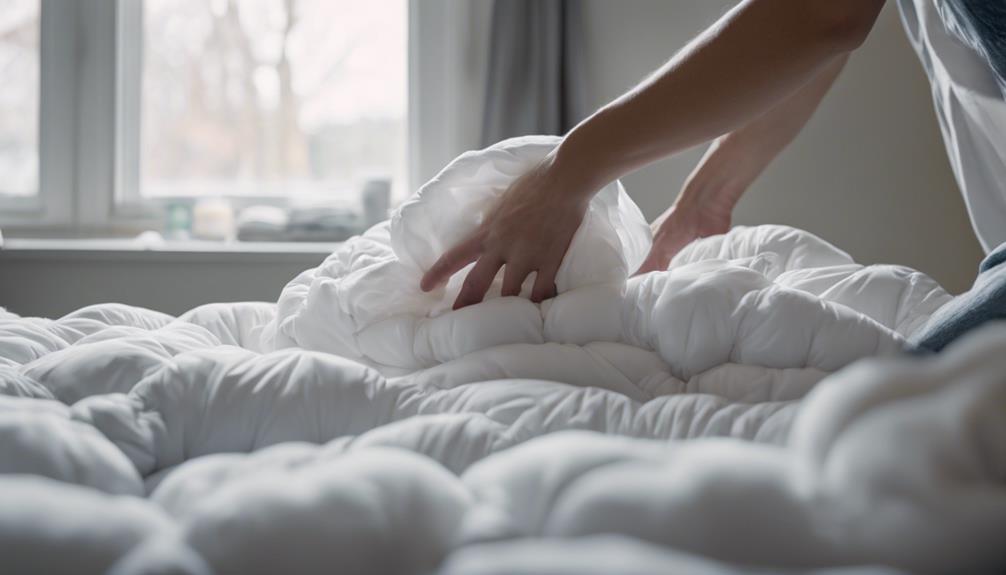When it comes to dealing with an old down comforter, there are numerous practical options available to us. Signs of wear such as yellow streaks, musty smell, clumped feathers, and roughness indicate that it’s time for a replacement. You can repurpose it as a pet bed, crafting fabric, or insulation. For cleaning, airing it out outdoors, removing feathers, and proper washing are essential. Think about donating to animal shelters or trying out DIY projects. Creative cushions, cozy pet beds, or improving fill power are all potential options. By exploring these suggestions, you will discover new ways to give your old comforter a fresh purpose.
Key Takeaways
- Repurpose old comforter for pet bedding or crafting projects.
- Properly clean and prepare down for reuse or new projects.
- Consider donating to animal shelters or local organizations.
- Explore creative DIY projects like making pillows or pet beds.
- Upgrade fill power or fabric for enhanced warmth and durability.
Signs of an Old Comforter
As we inspect an old comforter, we may notice distinct yellow or brown streaks on the bedding, signaling wear and tear. These streaks are often a result of sweat and stains accumulating over time, indicating that the comforter has been well-used. Additionally, an old comforter may emit a moldy odor, further highlighting the need for replacement. When examining the comforter, clumped feathers and a ruffled cover may also be apparent, affecting the overall texture and appearance of the bedding.
Moreover, signs of an old comforter extend beyond just visual cues. Loss of comfortability, increased heaviness, and a general roughness in texture are all indicators that the comforter has surpassed its prime. These factors not only impact the aesthetic appeal of the bedding but also contribute to a decrease in its functionality and comfort level. Recognizing these signs is essential in determining when it's time to replace an old comforter with a fresh, cozy alternative.
Repurposing Options

When considering what to do with an old down comforter, there are several repurposing options to explore.
Transform it into a cozy pet bed for added warmth and comfort, or repurpose the fabric for crafting projects such as quilting or patchwork.
Additionally, the fabric can be used to create draft stoppers or insulation for windows and doors, providing both practicality and sustainability.
New Pet Bed
Repurposing an old down comforter into a cozy pet bed involves sewing a cover for added comfort and warmth. Using a sewing machine, you can repurpose the down from the comforter to stuff a custom pet bed for your furry companion.
By upcycling the old comforter in this way, you not only provide a comfortable sleeping space for your pet but also guarantee durability. To make maintenance easier, consider adding a zippered cover to the pet bed, allowing for convenient washing.
Transforming the old comforter into a new pet bed is a creative way to give your pet a cozy spot while also reducing waste. This DIY project offers a practical and sustainable solution for both you and your furry friend.
DIY Pillow Inserts
Let's repurpose that old down comforter into cozy DIY pillow inserts for added comfort and support. Here are some simple steps to create custom-sized inserts:
- Cutting: Measure and cut the old comforter material to match the size of the desired pillow insert.
- Stuffing: Fill the pillow insert with the down from the old comforter, ensuring it's evenly distributed for best comfort.
- Sewing: Secure the edges of the insert by sewing them together to keep the stuffing in place.
- Customization: Tailor the inserts to fit different pillow sizes and shapes for a personalized touch.
- Sustainability: Upcycling old comforters into pillow inserts is a creative and eco-friendly way to extend their usefulness.
Insulation Material
Considering repurposing options for insulation material, we can explore innovative ways to utilize the down from old comforters.
The down can serve as effective insulation for draft stoppers or window insulation, helping to keep the cold air out and the warmth in.
Additionally, repurposing the down as stuffing for DIY pillows or cushions can provide extra comfort and coziness in your home.
For pet owners, using the down to create homemade pet beds offers a warm and soft sleeping area for furry friends.
Another creative idea is to make a cozy weighted blanket by upcycling the old comforter, perfect for relaxation and comfort.
Exploring crafting projects like quilting or patchwork using the fabric from the old comforter can also lead to unique and practical uses.
Cleaning and Preparing Down

When cleaning and preparing down, it's important to strip down outdoors on a non-windy day to prevent feathers from scattering. Use paper bags for easy transfer and organization of the down, and remove any small pin feathers present.
Remember to avoid washing down if possible to maintain its loft and quality.
Washing Down Comforter
To properly clean and prepare a down comforter, begin by stripping it down outdoors on a calm day to prevent any mess. Here are some tips for washing down comforters:
- Use paper bags to transfer and sort down during the cleaning process.
- Prep the down by removing small pin feathers if present before washing.
- It's best to avoid washing down if possible to maintain its quality.
- Proper prepping involves washing, drying, and fluffing down for reuse or repurposing.
Drying Down Properly
After washing down comforters, the next essential step is guaranteeing they're properly dried to maintain their fluffiness and prevent clumping.
To dry a re-covered comforter, air dry it thoroughly to prevent clumping and maintain its loft. If using a dryer, opt for low heat settings and toss in clean tennis balls to fluff up the down. During the drying process, regularly fluff and shake the comforter to prevent any clumping.
Make sure the comforter is fully dried without any lingering dampness or odor. Avoid compacting the down while drying to ensure peak loft and insulation.
Fluffing and Storing
Fluffing and storing down requires careful handling to maintain its loft and cleanliness. When dealing with old down comforters, follow these steps:
- Shake and air out the down outdoors on a calm day to restore loft and remove dust.
- Use paper bags to transfer and sort down to prevent loss and maintain cleanliness.
- Remove any small pin feathers present to enhance the overall quality and comfort of the down.
- Avoid washing down whenever possible to preserve its natural oils and loftiness.
- Properly prep down by washing, drying, and fluffing it before using it in new projects for best results.
Making Pillows and Cushions

Let's repurpose the down from an old comforter to stuff homemade pillows and cushions for added comfort. By using the fabric from the comforter, you can create custom pillowcases or cushion covers that match your decor perfectly.
Upcycling the down into throw pillows or floor cushions offers a cozy and sustainable home decor choice. Transform those old down comforters into body pillows or bolster cushions, ideal for lounging and relaxation.
For a personalized touch, consider mixing the down with other materials like memory foam or polyester fill to create a unique cushion or pillow blend. These options not only breathe new life into your comforter but also provide you with comfortable and stylish additions to your living space.
Get creative with your designs and enjoy the comfort and satisfaction that comes with repurposing your old down comforter into something new and useful.
Crafting a Pet Bed

Repurpose your old down comforter by creating a cozy pet bed for your furry companion. Using the down from the comforter will provide added warmth and coziness for your pet.
Sew a durable cover for the pet bed using the fabric from the old down comforter, ensuring both comfort and longevity. It's important to make sure the pet bed is washable for easy maintenance, keeping it fresh and clean for your pet.
By customizing the size of the pet bed, you can cater to your pet's specific sleeping preferences, providing them with a comfortable and personalized sleeping space.
Crafting a pet bed from your old down comforter is a practical and sustainable way to repurpose the comforter while giving your pet a comfortable place to rest.
Donating to Local Organizations

Consider donating your old down comforter to local organizations to provide warmth and comfort to those in need. One option is to reach out to animal shelters, as they often welcome donations of old comforters to help create cozy bedding for animals awaiting adoption. By donating your down comforter to an animal shelter, you can help guarantee that furry friends have a comfortable place to rest while they wait for their forever homes.
In addition to animal shelters, consider reaching out to local orphanages and nursing homes. These organizations may also appreciate receiving old down comforters to provide direct assistance to those in need of warmth and comfort. By donating your comforter to these establishments, you can make a meaningful impact on the lives of individuals who may benefit from a little extra warmth during colder seasons.
Before donating, make sure to verify the condition of your old comforter. Washing and deodorizing it, if necessary, can ensure that it's in good shape for donation. Choose reputable organizations to donate to, guaranteeing that your contribution will be properly distributed and have a positive impact on the recipients.
Recycling for Sustainability

Donating your old down comforter to local organizations is a thoughtful way to provide warmth and comfort, but recycling for sustainability offers an alternative approach that reduces waste and promotes environmental preservation. Recycling down comforters can greatly decrease the amount of waste ending up in landfills, contributing to a circular economy.
Composting the down from old comforters not only provides a sustainable disposal method but also offers valuable garden nitrogen. Repurposing old textiles like down comforters aligns with eco-friendly practices and supports environmental sustainability efforts.
Sustainable disposal methods, such as recycling down comforters, have positive environmental benefits and help in reducing our carbon footprint. Researching local recycling programs for textiles, including old down comforters, can play an important role in minimizing environmental impact and promoting sustainability.
Enhancing Fill Power and Fabrics

Improving the fill power and fabrics of an old down comforter can greatly enhance its warmth and insulation capabilities. Upgrading to 800-900 fill-power goose down can greatly boost the comforter's ability to keep you warm during chilly nights.
If your comforter has uneven distribution of down, consider custom orders to guarantee ideal comfort. Using down-proof fabric imported from Europe for re-covering maintains quality and durability. When sewing the comforter into billowy squares, you help distribute the down evenly, ensuring consistent warmth throughout.
Before re-covering, it's advisable to enlist expert cleaning services to make sure the comforter is in top condition for refurbishing. Adding a duvet cover can further enhance the comforter's aesthetics and protect it from wear and tear.
Creative DIY Projects

Let's explore innovative ways to repurpose old down comforters through engaging DIY projects. One exciting project is transforming the comforter into cozy sleeping bags for camping or sleepovers. Here are a few more ideas to get your creative juices flowing:
- Create Custom Pillows: Use the down to fill new pillows for added comfort and support.
- Crafting Projects: Repurpose the down for quilting or patchwork to add a unique touch to your creations.
- Custom Pet Beds: Make fluffy pet beds for your furry friends using the down from old comforters.
- Zippered Pillowcases: Stuff the down into zippered pillowcases to make custom pillows or cushions for various uses.
- Avoid the Mess: Be cautious when handling the comforter to prevent a mess and make sure the down is utilized effectively in all your DIY projects.
With these ideas, you can breathe new life into your old down comforter and create practical items for yourself and your loved ones.
Frequently Asked Questions
When Should You Throw Away a Down Comforter?
When it's time to part ways with a down comforter varies based on signs like discoloration, odor, clumping, or loss of warmth. A heavy, rough comforter may signal it's time to move on.
Consider donating to shelters, repurposing, or recycling to reduce waste. Responsible disposal means checking the condition, looking into donation options, and minimizing environmental impact.
Ultimately, knowing when to toss a down comforter involves evaluating its wear and tear.
How to Dispose of a Down Duvet?
When disposing of a down duvet, it's essential to first research local recycling programs that accept textiles for eco-friendly disposal. Evaluate the comforter's condition to determine salvage, repurpose, or recycling possibilities. Consider donating to organizations that repurpose textiles for charitable causes. Check for hazardous materials before disposal. Follow proper disposal methods to minimize environmental impact.
Remember to handle with care for a greener solution.
What Can I Do With an Old Feather Duvet?
When you have an old feather duvet, you can repurpose it in various ways to give it new life.
Consider using the fabric for crafting, creating draft stoppers, or insulation.
The down can be used as stuffing for pillows or cushions.
Another idea is to turn the duvet into a DIY weighted blanket for relaxation.
With some creativity, you can find practical and cozy uses for your old feather duvet.
How to Revive an Old Down Comforter?
Reviving an old down comforter can be achieved through professional refurbishing or hand-mending. Before investing in refurbishing, verify the down's quality for longevity.
Avoid heavy sewed-on coverings for comfort. Washing the comforter can be labor-intensive yet revives fluffiness and cleanliness.
Consider these options to extend the comforter's life and save on replacements.
Should I Reuse My Old Down Comforter as a Cover for My New Comforter?
Yes, a down comforter cover is a necessity for protecting your new comforter. However, using your old down comforter as a cover may not provide the same level of protection. It’s best to invest in a new cover to ensure your new comforter stays in top condition for longer.
Conclusion
To sum up, repurposing an old down comforter is a sustainable and creative way to give it new life. Did you know that every year, millions of tons of textiles end up in landfills? By finding alternative uses for your old comforter, you can help reduce waste and contribute to a more eco-friendly lifestyle.
So whether you turn it into pillows, donate it to a local organization, or recycle it for sustainability, there are plenty of options to choose from.










